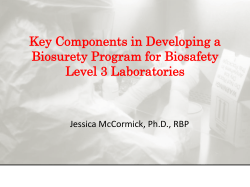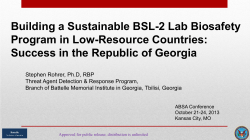
Sample Standard Operating Procedure Requirements for BSL2 Containment
Print Form Sample Standard Operating Procedure Requirements for BSL2 Containment Principal Investigators (PI) at the University of Toledo have the responsibility to inform the laboratory personnel of the hazards associated with biological agents and the appropriate research procedures. When using hazardous or regulated biological agents the PI must prepare a written Standard Operating Procedure (SOP) outlining the necessary precautions to safely conduct research. A SOP is a set of specific guidelines designed to address the methods that will be used and the safe handling of biological agents in each designated laboratory. The SOP must be available at all times in the designated laboratory. A well-written SOP can be used to satisfy several compliance requirements. SOP should be written for all procedures that pose an identified potential risk to the health and safety of the laboratory personnel, although a separate SOP does not need to be written for each individual experiment, procedures with the same hazards can be combined into one SOP. The process of writing SOPs requires an individual to think through all steps of a procedure and perform a risk assessment before work has begun. The best approach to writing an SOP is to do it, write it and test it. Be brief and succinct; the shorter the better. A SOP template is provided below. BSL2 requirements also include appropriate biohazard labeling. An example of appropriate signage for a laboratory door is attached at the end of the template for your use. Remember, other signs may also be appropriate, as long as they include the necessary information (Biohazard Symbol, Biocontainment Level, name of agent and any necessary requirements to take prior to entering the lab, and PI and lab contact information). Sample Standard Operating Procedure Template For Handling (list organisms or human materials) at BSL2 Containment Please edit and complete as necessary to address Biosafety Risks within your laboratory Title of Procedure: Introduction and Purpose of Work: PI: Issue Date: Prepared by: Lab Location: Revision Date: Approval Signature: Applicable Regulatory Statutes: RISK ASSESSMENT: Hazard Identification and Risk of Exposure to the Hazards: Routes of Exposure: Exposure risks: MEDICAL CONSIDERATIONS: Medical Screening and Surveillance (if necessary): • • Exposure Profile for those working with animals Must be offered the hepatitis B vaccination Personnel may also be offered vaccines or special counseling depending on the organism(s) handled in the lab and availability of vaccines or prophylaxis. Accidental exposures, such as splash to the face or a sharps injury shall be reported immediately to University Health by dialing 419-383-3000. A representative will help categorize the risk of developing occupationally-acquired infection and provide advice on an appropriate post-exposure treatment. PRECAUTIONS: All laboratory work shall fully comply with biosafety level -2 (BSL-2) containment as described in the current edition of the CDC/NIH’s Biosafety in the Microbiological and Biomedical Laboratories : http://www.cdc.gov/od/ohs/biosfty/bmbl5/bmbl5toc.htm Procedural Methods and Materials: Signage & Labeling : Access to laboratory: Personal Protective Equipment (PPE) : Methods to minimize personal exposure: Methods to prevent the release of infectious agents: Specimen transport and removal of material(s) from the laboratory: Standard microbiological methods: Cleaning & Disinfection: Waste Generation and Disposal Methods: Spill and Accident Response Procedure: TRAINING: Training Requirements: Workers conducting research under this procedure must comply with the following training requirements: • • • • Complete Lab Safety Training provided by Safety and Health either in the classroom or online. This training is required annually and is documented by Safety and Health. Complete Biosafety Training provided at the same website above. Insert additional training requirements here (i.e., Bloodborne Pathogens training for human blood samples). This includes documentation of personnel reading and understanding of this lab-specific SOP. Note: If you are going to transport biological materials offsite you are required to attend a Infectious Substance Shipping and Packaging Class. Example of signage that will be provided by Safety and Health for laboratory doorway:
© Copyright 2025





















